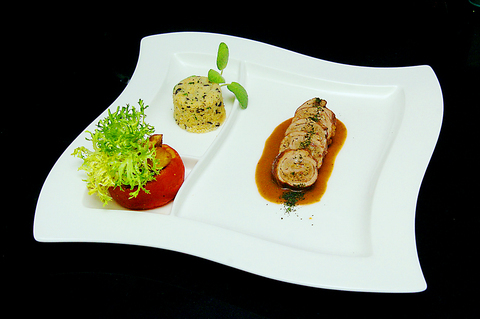The VVG Bistro is a small French restaurant that can be difficult to find if you haven't been told its exact address. Although its entrance is half obscured by shrubbery, it has nevertheless generated a following and can get quite crowded on the weekends. The creative dishes provided solid fare that lives up to the restaurant's name: Very Very Good.
Upon entering the eatery, one is greeted by a wooden horse towing a wagon of fruits. The walls are lined with bottles, jars and cardboard artwork. The restaurant was designed by owner Grace Wang (汪麗琴) with the help of her friends. It has a Bohemian feel with its mismatched furniture and colorful water glasses. The staff are young and dedicated, but be prepared to wait a while before your food comes.
The kitchen takes up the center of the restaurant, where you can see the chefs always busy preparing dishes. This activity produces a lively atmosphere for conversation.

PHOTO: SUNG CHIH-HSIUNG, TAIPEI TIMES
The VVG Bistro offers French cuisine that is sometimes prepared in inventive ways. To start off, the watercress and coriander green soup, a consomme garnished with bacon, is served in a tall cocktail glass. Its thick flavor and interesting presentation makes up for the fact that it's a small portion.
The main courses range from NT$520 to NT$680. The fisherman's dream is a spicy seafood combination with prawns, squid, clams, oysters and tiny shrimps. It's well cooked and topped with savory fettuccini. The roasted chicken dome is a large fist-sized ball of tender meat on a bed of bell peppers and risotto. There is an accompanying chocolate sauce which provides an interesting taste combination.
Each main course comes with a plate of bread and for an additional NT$60 you can add a cup of homemade pesto sauce. The pesto achieves a balance in the strength of its garlic and olive oil that most pesto sauces do not. For less expensive fare, the linguine dishes in the pasta section are priced at NT$320 to NT$380 and are just as filling as the main courses.
While the main entrees are consistently good, the weekend brunch (NT$420, served from 11am to 4pm) is the most popular lunchtime order. It offers a full variety of breakfast items, including a refreshing chicken roulade, an amaretto pound cake, strawberries with homemade yogurt, and a choice between fruit champagne or a glass of cucumber juice. The brunch also includes tea or cafe au lait. The cafe au lait is an entertaining experience as it is served in generous amounts in a large soup bowl. VVG Bistro also has a wide range of other teas, coffees and alcoholic beverages, along with a selection of homemade desserts.

On April 26, The Lancet published a letter from two doctors at Taichung-based China Medical University Hospital (CMUH) warning that “Taiwan’s Health Care System is on the Brink of Collapse.” The authors said that “Years of policy inaction and mismanagement of resources have led to the National Health Insurance system operating under unsustainable conditions.” The pushback was immediate. Errors in the paper were quickly identified and publicized, to discredit the authors (the hospital apologized). CNA reported that CMUH said the letter described Taiwan in 2021 as having 62 nurses per 10,000 people, when the correct number was 78 nurses per 10,000

As we live longer, our risk of cognitive impairment is increasing. How can we delay the onset of symptoms? Do we have to give up every indulgence or can small changes make a difference? We asked neurologists for tips on how to keep our brains healthy for life. TAKE CARE OF YOUR HEALTH “All of the sensible things that apply to bodily health apply to brain health,” says Suzanne O’Sullivan, a consultant in neurology at the National Hospital for Neurology and Neurosurgery in London, and the author of The Age of Diagnosis. “When you’re 20, you can get away with absolute

May 5 to May 11 What started out as friction between Taiwanese students at Taichung First High School and a Japanese head cook escalated dramatically over the first two weeks of May 1927. It began on April 30 when the cook’s wife knew that lotus starch used in that night’s dinner had rat feces in it, but failed to inform staff until the meal was already prepared. The students believed that her silence was intentional, and filed a complaint. The school’s Japanese administrators sided with the cook’s family, dismissing the students as troublemakers and clamping down on their freedoms — with

As Donald Trump’s executive order in March led to the shuttering of Voice of America (VOA) — the global broadcaster whose roots date back to the fight against Nazi propaganda — he quickly attracted support from figures not used to aligning themselves with any US administration. Trump had ordered the US Agency for Global Media, the federal agency that funds VOA and other groups promoting independent journalism overseas, to be “eliminated to the maximum extent consistent with applicable law.” The decision suddenly halted programming in 49 languages to more than 425 million people. In Moscow, Margarita Simonyan, the hardline editor-in-chief of the